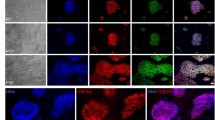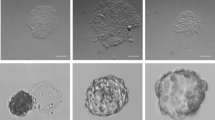Abstract
We recently reported the development of TeSR1, a serum-free, animal product–free medium that supports the derivation and long-term feeder-independent culture of human embryonic stem cells1. Although the derivation of new human embryonic stem cell lines in those defined conditions offered an important proof of principle, the costs of some of the defined components in that culture system made it impractical for everyday research use. Here we describe modifications to the medium (mTeSR1) that include the use of animal-sourced proteins (bovine serum albumin (BSA) and Matrigel) and cloned zebrafish basic fibroblast growth factor (zbFGF). We include a simple protocol that allows purification of up to 100 mg zbFGF in less than three days (Fig. 1), an amount sufficient to make 1,000 l of mTeSR1 medium. The modifications presented here make mTeSR1 practical for routine research use, and the protocols presented are those currently used in our laboratory for standard human embryonic stem cell culture.

Outline of zbFGF purification protocol.
*Note: In the version of this Protocol initially published, the references were numbered incorrectly. The error has been corrected in the HTML and PDF versions of the article.
This is a preview of subscription content, access via your institution
Access options
Subscribe to this journal
Receive 12 print issues and online access
$259.00 per year
only $21.58 per issue
Buy this article
- Purchase on Springer Link
- Instant access to full article PDF
Prices may be subject to local taxes which are calculated during checkout


Similar content being viewed by others
Change history
24 August 2006
During production of the manuscript, the references were incorrectly numbered. The ordering within the text is fine and should remain the same, but the list of references needs to be reordered. The new reference order is attached in a Word document and is also as follows:
References
Ludwig, T.E. et al. Derivation of human embryonic stem cells in defined conditions. Nat. Biotechnol. 24, 185–187 (2006).
Amit, M. et al. Clonally derived human embryonic stem cell lines maintain pluripotency and proliferative potential for prolonged periods of culture. Dev. Biol. 227, 271–278 (2000).
Xu, R.H. et al. Basic FGF and suppression of BMP signaling sustain undifferentiated proliferation of human ES cells. Nat. Methods 2, 185–190 (2005).
Levenstein, M.E. et al. Basic FGF support of human embryonic stem cell self-renewal. Stem Cells 24, 568–574 (2005).
Xu, C. et al. Basic fibroblast growth factor supports undifferentiated human embryonic stem cell growth without conditioned medium. Stem Cells 23, 315–323 (2005).
Wang, L., Li, L., Menendez, P., Cerdan, C. & Bhatia, M. Human embryonic stem cells maintained in the absence of mouse embryonic fibroblasts or conditioned media are capable of hematopoietic development. Blood 105, 4598–4603 (2005).
Amit, M., Shariki, C., Margulets, V. & Itskovitz-Eldor, J. Feeder layer- and serum-free culture of human embryonic stem cells. Biol. Reprod. 70, 837–845 (2004).
Beattie, G.M. et al. Activin A maintains pluripotency of human embryonic stem cells in the absence of feeder layers. Stem Cells 23, 489–495 (2005).
Vallier, L., Reynolds, D. & Pedersen, R.A. Nodal inhibits differentiation of human embryonic stem cells along the neuroectodermal default pathway. Dev. Biol. 275, 403–421 (2004).
James, D., Levine, A.J., Besser, D. & Hemmati-Brivanlou, A. TGFb/activin/nodal signaling is necessary for the maintenance of pluripotency in human embryonic stem cells. Development 132, 1273–1282 (2005).
Pyle, A.D., Lock, L.F. & Donovan, P.J. Neurotrophins mediate human embryonic stem cell survival. Nat. Biotechnol. 24, 344–350 (2006).
Herszfeld, D. et al. CD30 is a survival factor and a biomarker for transformed human pluripotent stem cells. Nat. Biotechnol. 24, 351–357 (2006).
Draper, J.S. et al. Recurrent gain of chromosomes 17q and 12 in cultured human embryonic stem cells. Nat. Biotechnol. 22, 53–54 (2004).
Seeger, A. & Rinas, U. Two-step chromatographic procedure for purification of basic fibroblast growth factor from recombinant Escherichia coli and characterization of the equilibrium parameters of adsorption. J. Chromatogr. A 746, 17–24 (1996).
McKiernan, S.H. & Bavister, B.D. Different lots of bovine serum albumin inhibit or stimulate in vitro development of hamster embryos. In Vitro Cell. Dev. Biol. 28A, 154–156 (1992).
Mather, J., Kaczarowski, F., Gabler, R. & Wilkins, F. Effects of water purity and addition of common water contaminants on the growth of cells in serum-free media. Biotechniques 4, 56–63 (1986).
Gabler, R., Hedge, R. & Hughes, D. Degradation of high purity water on storage. J. Liq. Chromatogr. 6, 2565–2570 (1983).
Acknowledgements
The methods described in this paper are those presently used by the Thomson Laboratory at the University of Wisconsin–Madison. We thank the many laboratory colleagues contributing to the preparation of this manuscript, particularly J. Frane, D. Faupel and J. Antosiewicz for editorial review. This work was supported in part by US National Institutes of Health grants R24-RR017721 and P20-GM069981, and funds from the University of Wisconsin Foundation.
Author information
Authors and Affiliations
Corresponding author
Ethics declarations
Competing interests
J.A.T. owns stock in and has served on the Board of Cellular Dynamics International (within the last two years), and owns stock in and serves on the Board of Stem Cell Products (within the last year).
Supplementary information
Rights and permissions
About this article
Cite this article
Ludwig, T., Bergendahl, V., Levenstein, M. et al. Feeder-independent culture of human embryonic stem cells. Nat Methods 3, 637–646 (2006). https://doi.org/10.1038/nmeth902
Published:
Issue Date:
DOI: https://doi.org/10.1038/nmeth902
This article is cited by
-
Development of synthetic modulator enabling long-term propagation and neurogenesis of human embryonic stem cell-derived neural progenitor cells
Biological Research (2023)
-
SARS-CoV-2 viral genes Nsp6, Nsp8, and M compromise cellular ATP levels to impair survival and function of human pluripotent stem cell-derived cardiomyocytes
Stem Cell Research & Therapy (2023)
-
DUSP6 is a memory retention feedback regulator of ERK signaling for cellular resilience of human pluripotent stem cells in response to dissociation
Scientific Reports (2023)
-
Efficient and safe single-cell cloning of human pluripotent stem cells using the CEPT cocktail
Nature Protocols (2023)
-
Temporal morphogen gradient-driven neural induction shapes single expanded neuroepithelium brain organoids with enhanced cortical identity
Nature Communications (2023)



